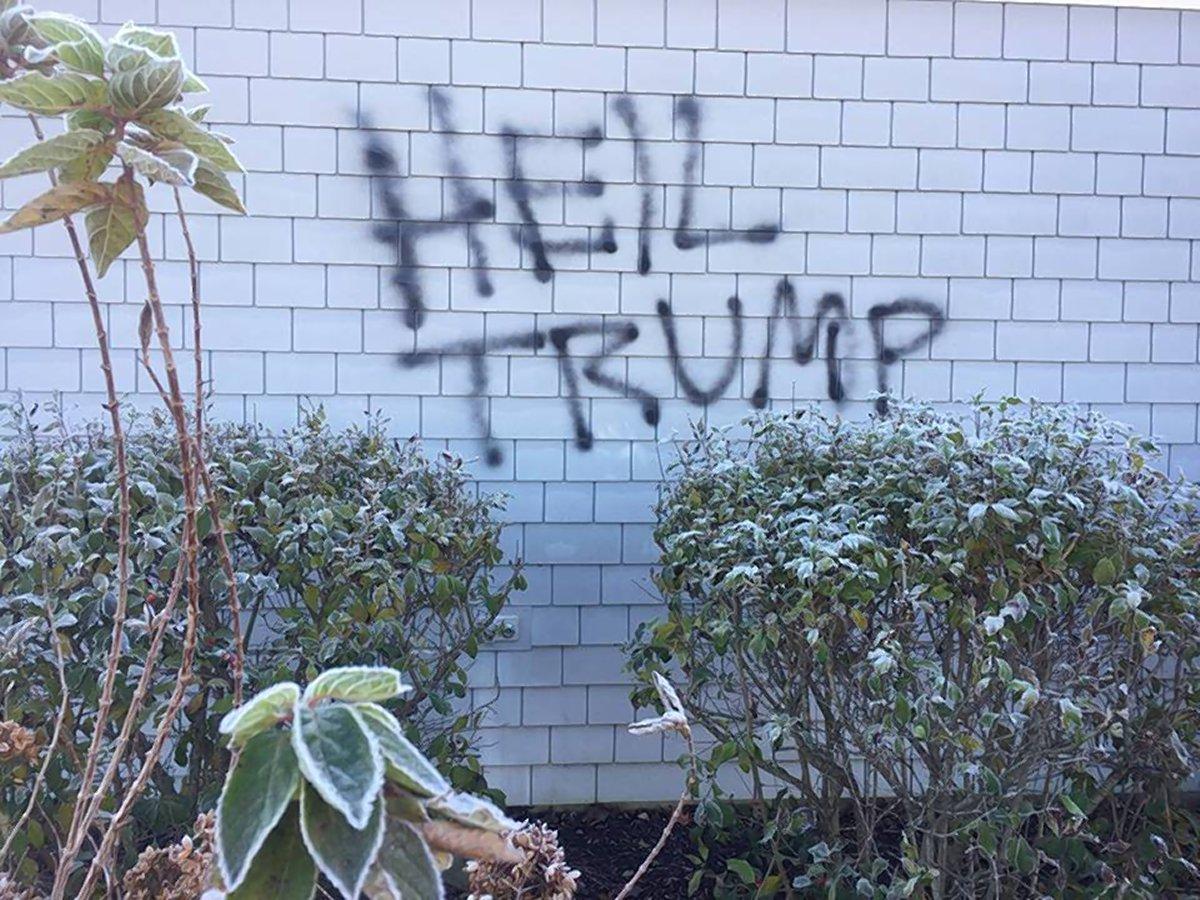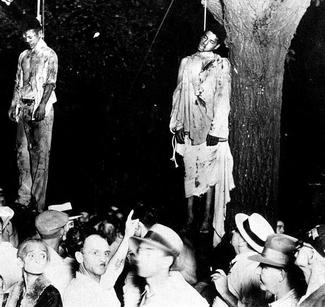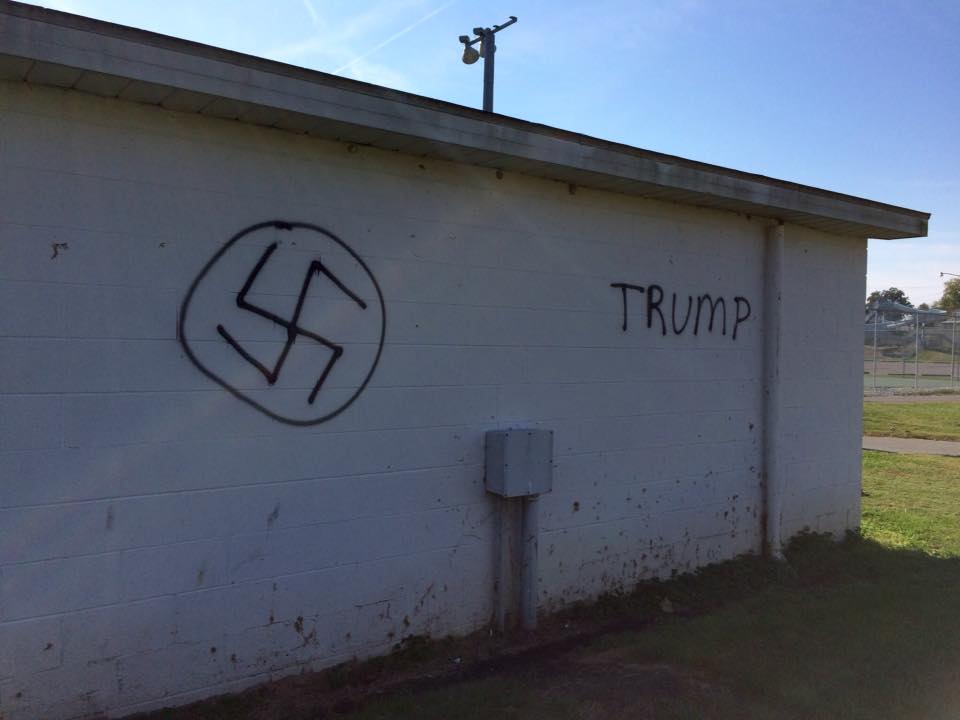
Vandalism at St. David’s Episcopal Church in Bean Blossom, Indiana included “Heil Trump,” a swastika, and “Fag Church.”
James Duffy, writing for the Fort Wayne Journal Gazette, has an article on the increase in abuse directed at Latinos, blacks, and Muslims in Fort Wayne, and an increase in anxiety felt by members of those groups.
Fort Wayne has seen incidents. The day of the rally, a garage on the city’s northeast side was spray-painted with the word “Trump,” and the house was later shot at.
. . .
Guillermo “Memo” Contreras, a deejay on Fort Wayne’s Spanish-language radio station La Unica 102.3 FM, said he receives at least seven phone calls a day now from parents whose children ask to be picked up from school because they are being bullied over Trump’s promise to build a wall along the southern border of the U.S. and Mexico.
Contreras, whose radio program runs 7 a.m. to 11 a.m., said he rarely received such phone calls from listeners before the election. One parent told him her child was told by a teacher not to speak Spanish.
. . .
The attacks the Muslim population is seeing are “a bit more verbal than anything else,” said Michael Spath, executive director at the Indiana Center for Middle East Peace in Fort Wayne. “Intimidation. (Comments such as) ‘you’re not wanted here’ and vulgar language are being used.”
. . .
Attending the forum was John Houser, principal of Wayne High School, whose student-athletes were subjected to an incident at a Nov. 8 girls basketball game at Norwell High School.
A cheering section started chanting “Build That Wall,” said Superintendent Scott Mills of Northern Wells Community Schools. The action was immediately stopped by high school principal Mark Misch, he said.
Fort Wayne is not the only Indiana area experiencing such things. For example, in Bean Blossom a church was vandalized with spray paint saying “Heil Trump,” “Fag Church,” and a swastika. In Tell City, the pool was vandalized with a swastika and “Trump”.

August 7, 1930 in Marion, Indiana. A white mob murders Thomas Shipp and Abram Smith. A man in the crowd poses for a picture.
It doesn’t take a lot of this kind of thing to make a members of a non-majority group feel extremely uneasy. And that’s not just them being delicate or fragile. We really aren’t that far historically from a time when white men felt comfortable having their pictures taken at a lynching.
What’s going on with all of this? Is it a new trend, a precursor to more frequent and more violent events to come? Is it just a few bad apples, being sensationalized by media outlets (mine included)? Are minority groups panicking more than the events warrant?
I couldn’t say. Growing up, I — and I think probably most Americans — were indoctrinated with the tale of Nazi Germany as a cautionary tale. It’s been overdone for sure. Mike Godwin was getting at that when he invented Godwin’s Law. Every Internet discussion thread devolved into Nazi comparisons. That said, when a political leader stokes ethnic resentment for political power, it’s tough not to draw comparisons. On the other hand, the United States in the late 2010s is not in the same dire economic state as 1930s Germany, nor are we suffering from postwar humiliation. So, the hope would be that we are not as vulnerable.
Similarly, I have no real ability to judge the reaction of minority groups who feel threatened by these incidents. I’m an upper middle class white professional in a community that is relatively diverse and prosperous. West Lafayette has a diverse nonwhite population, but because of the presence of Purdue, many members of that population are of a professional class. We talk of race and wealth in our politics, but we very often do not discuss social class as a thing distinct from those factors. And I think that creates something of a blind spot in our political discussions.
What should we do about this? Again, I’m not full of answers. Specific instances should, where criminal, be investigated and prosecuted. Noncriminal acts should, at a minimum, trigger social disapproval. Beyond that, Trump supporters of good will should avoid the temptation to perceive discussion of these issues as a personal attack and reflexively dismiss them as unimportant.
For my part, I think I need to do a better job of respecting the feelings of those who feel attacked and marginalized in a lot of ways – whether it’s the black man who fears the police, the woman who fears sexual assault, American who fears terrorist attacks, the gun owner who fears crime, the Christian or Muslim who fears the loss of religious freedoms, or whatever it might be. It’s easy for me to sit back and philosophically note that the statistics don’t necessarily support the level of fear. The fear is, nevertheless, very real to the person experiencing it. The question is what can I (and what can we) do to reduce this pervasive anxiety. Compassion for the person experiencing the anxiety is one reason to address it. But the larger reason is that the anxiety is corroding our social institutions and our relationships to one another.

With some people, it’s not difficult to arouse their negative nastiness that lies beneath their veneer of civilized control. But among those folk, the distance between the feeling and action is small. Once they feel free to verbally express their hate, they feel entitled to show it. That’s why people like Mr. Trump are so dangerous. He opens the gate for people to go down that road. That’s also the reason why people in the public eye need to craft their language carefully.
Like when the electricity goes out and you begin to appreciate the fact that we are not that far from the caves, this phenomenon reminds us that civilized behavior and positive aspirations are the veneer for so many that doesn’t run very deep. We need to remember that the dinosaur is often just below the surface, despite our mistaken belief that everyone is just good folks if you give them a chance. If you believe that, just make sure they’re not carrying a gun or a rope when you turn around.
Not sure if this link will work as posted but it is a very fitting piece.
http://www.vox.com/science-and-health/2016/11/22/13638374/buddhist-monk-mindfulness
I like this: